
Freesia is a genus of herbaceous perennial flowering plants in the family Iridaceae, first described as a genus in 1866 by Christian Friedrich Ecklon (1886) and named after the German botanist and medical practitioner, Friedrich Freese (1795-1876). It is native to the eastern side of southern Africa, from Kenya south to South Africa, most species being found in Cape Provinces. Species of the former genus Anomatheca are now included in Freesia. The plants commonly known as "freesias", with fragrant funnel-shaped flowers, are cultivated hybrids of a number of Freesia species. Some other species are also grown as ornamental plants.

Tulbaghia is a genus of monocotyledonous herbaceous perennial bulbs native to Africa, belonging to the amaryllis family. It is one of only two known genera in the society garlic tribe within the onion subfamily. The genus was named for Ryk Tulbagh (1699–1771), one time governor of The Cape of Good Hope.

Kniphofia is a genus of perennial flowering plants in the family Asphodelaceae, first described as a genus in 1794. Species are native to Africa. Common names include tritoma, red hot poker, torch lily and poker plant.

Crocosmia (;), also known as montbretia, is a small genus of flowering plants in the iris family, Iridaceae. It is native to the grasslands of southern and eastern Africa, ranging from South Africa to Sudan. One species is endemic to Madagascar.

Dietes is a genus of rhizomatous plants of the family Iridaceae, first described as a genus in 1866. Common names include wood iris, fortnight lily, African iris, Japanese iris and butterfly iris, each of which may be used differently in different regions for one or more of the six species within the genus.
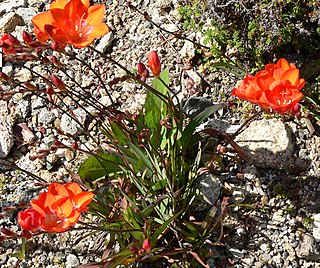
Tritonia is a genus of flowering plants in the iris family first described as a genus in 1802. They are naturally distributed across southern Africa, with a high concentration of species in Cape Province of western South Africa. The genus is closely related to the genus Ixia.

The Natal red rock hare or greater red rock hare is a species of mammal in the family Leporidae. It has a slightly grizzled, grayish brown head and reddish brown upperparts. The dense fur is thick and rougher than other rock hares. It is endemic to Africa, and found in southeastern provinces of South Africa, eastern Lesotho, Eswatini, and southern Mozambique. It is a herbivore, primarily feeding on grass. It breeds throughout the year, and one or two pups are usually born in the summer. It is rated as a species of least concern on the IUCN Red List of Endangered Species.

Protea comptonii, also known as saddleback sugarbush, is a smallish tree of the genus Protea in the family Proteaceae. It is found in South Africa and Eswatini.
Prosphytochloa is a genus of African plants in the grass family. The only known species is Prosphytochloa prehensilis, native to Eastern Cape Province, KwaZulu-Natal, Eswatini, Mpumalanga, and Limpopo.
Lintonia is a genus of African plants in the grass family.

Eumorphia is a genus of African flowering plants in the daisy family. It has white flowers.
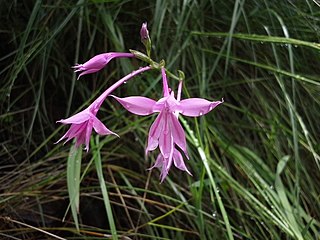
Radinosiphon is a genus of flowering plants in the family Iridaceae first described as a genus in 1932. It is native to southern + southeastern Africa.

Schizochilus is a genus of flowering plants from the orchid family, Orchidaceae. It is native to southern and eastern Africa.
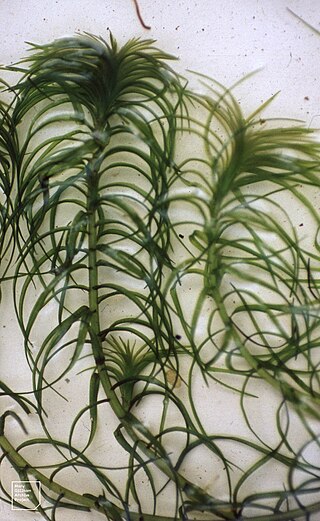
Lagarosiphon is a genus of aquatic plants described as a genus in 1841. It is native to Africa and Madagascar. It is dioecious, with male and female flowers produced on separate plants.
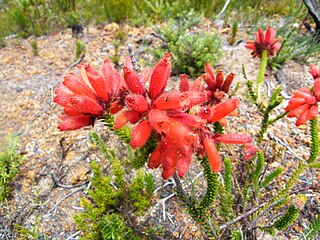
Erica cerinthoides is a species of heath native to South Africa, Lesotho and Eswatini. Common names include fire erica, fire heath, red hairy heath, rooihaartjie or klipheide. Throughout its range the species shows marked variation in habit, flower characteristics and hairiness. A form with white flowers is found in Eswatini and the South African province of Mpumalanga while the variety E. cerinthoides var. barbertona has shorter flowers.

Bonatea is a genus of orchids native to tropical and southern Africa, with one species extending into Yemen and Saudi Arabia.

Karomia is a genus of plants in the family Lamiaceae. The genus was introduced in 1932 by the botanist Paul Louis Amans Dop (1876-1954) in 'Bulletin du Muséum national d'histoire naturelle' (Paris) ser. 2. 4: 1052, for the single species Karomia fragrans. It is native to eastern and southern Africa, Madagascar, and Vietnam.
- Karomia fragransDop – Vietnam
- Karomia gigas(Faden) Verdc. – Kenya, Tanzania
- Karomia humbertii(Moldenke) R.Fern. – Madagascar
- Karomia macrocalyx(Baker) R.Fern. – Madagascar
- Karomia madagascariensis(Moldenke) R.Fern. – Madagascar
- Karomia microphylla(Moldenke) R.Fern. – Madagascar
- Karomia mira(Moldenke) R.Fern. – Madagascar
- Karomia speciosa(Hutch. & Corbishley) R.Fern. – Mozambique, Eswatini, South Africa
- Karomia tettensis(Klotzsch) R.Fern. – Mozambique, Malawi, Zimbabwe, Zambia
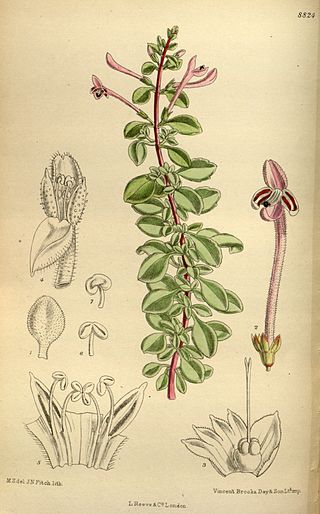
Thorncroftia is a genus of flowering plants in the mint family, Lamiaceae, first described as a genus in 1912. It is native to southern Africa.
- Thorncroftia greeniiChangwe & K.Balkwill - KwaZulu-Natal
- Thorncroftia longifloraN.E.Br - Mpumalanga, Eswatini
- Thorncroftia lotteriT.J.Edwards & McMurtry - Mpumalanga
- Thorncroftia mediaCodd - Northern Province of South Africa
- Thorncroftia succulenta(R.A.Dyer & E.A.Bruce) Codd - Northern Province of South Africa
- Thorncroftia thorncroftii(S.Moore) Codd - Mpumalanga, Eswatini, Northern Province of South Africa
Miraglossum is a genus of plants in the family Apocynaceae, first described as a genus in 1984. It is native to southern Africa.
- Miraglossum anomalum(N.E. Br.) Kupicha - South Africa
- Miraglossum davyi(N.E. Br.) Kupicha - South Africa
- Miraglossum laeveKupicha - Limpopo, Mpumalanga, Gauteng
- Miraglossum pilosum(Schltr.) Kupicha - KwaZulu-Natal
- Miraglossum pulchellum(Schltr.) Kupicha - Eswatini, Gauteng
- Miraglossum superbumKupicha - KwaZulu-Natal
- Miraglossum verticillare(Schltr.) Kupicha - KwaZulu-Natal















